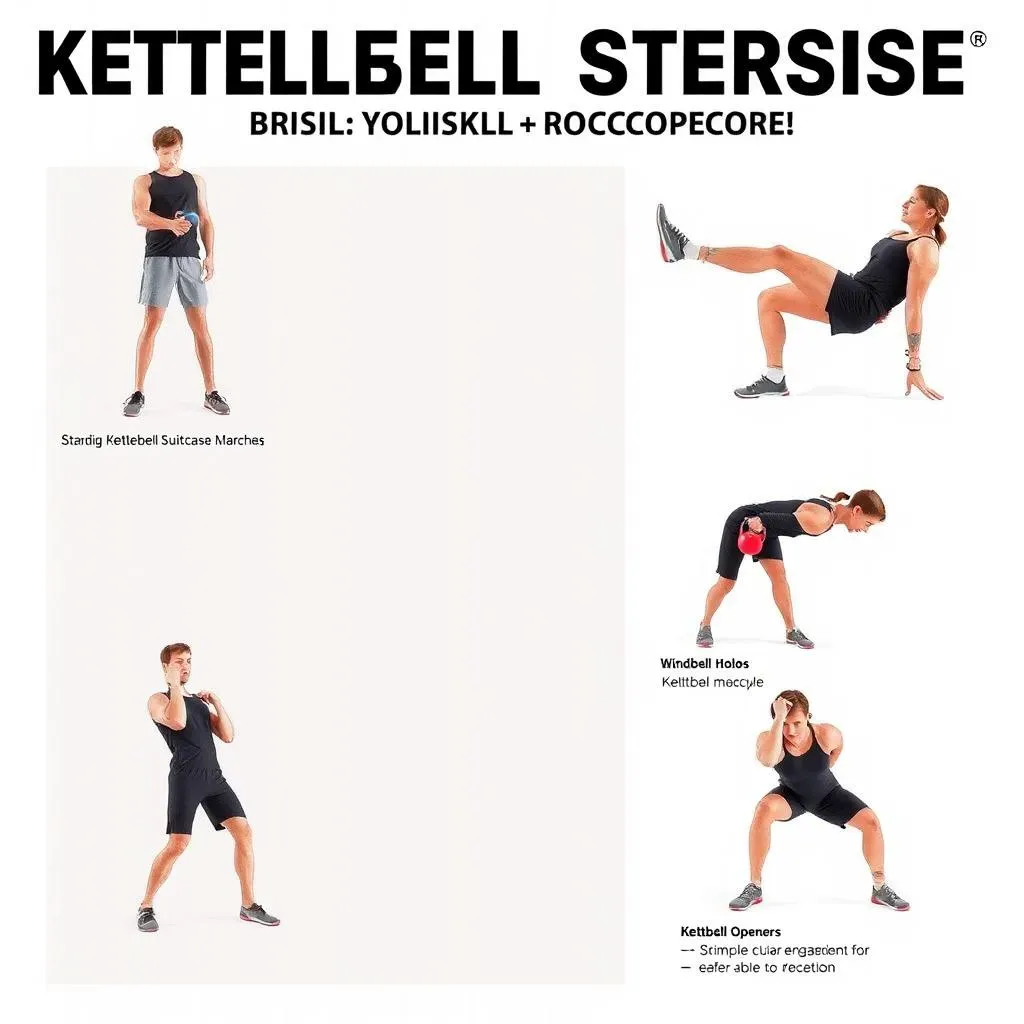Table of Contents
Tired of endless crunches that just don't seem to cut it? What if I told you there's a better way to carve out a strong, functional core? Forget lying on the floor; it's time to stand up and grab a kettlebell! This isn't your average ab workout. We're diving into the world of standing kettlebell exercises, a dynamic approach that not only targets your abs but also engages your entire body. This article will guide you through five killer moves that will challenge your core stability, build strength, and boost your overall fitness. We will explore the power of a "ab workout kettlebell standing", showing you how to move beyond the mat and into a more effective way to train. Get ready to feel the burn as we break down each exercise, highlighting proper form and technique. Plus, we'll uncover the amazing benefits of this standing approach, proving that sometimes, the best core work happens on your feet. Let's get started!
The Power of Standing Kettlebell Ab Workouts

The Power of Standing Kettlebell Ab Workouts
Why Stand When You Can Crunch?
Okay, so you've probably spent countless hours on the floor, crunching away, hoping for that six-pack to magically appear. I get it, I've been there. But here's the thing: traditional ab exercises often isolate your core, neglecting the fact that your abs work in tandem with your entire body during everyday movements. That’s where standing kettlebell exercises swoop in like a superhero. They engage your core in a way that crunches simply can't match. Think about it: you're not just working your abs; you're also firing up your obliques, your back, and even your legs. It's a full-body party, and your core is the guest of honor.
Standing core work with a kettlebell isn't just about vanity, it's about function. When you're moving and balancing with a weight, you're improving your real-world strength and stability. Imagine carrying groceries, lifting a suitcase, or even just walking on uneven ground – these are all activities where a strong, stable core is crucial. By training your core in a standing position, you're building the kind of strength that translates directly into your daily life, making you more resilient and capable. It's about building a core that's not just showy, but truly powerful and practical.
More Than Just Abs
It's easy to think of your core as just the "six-pack" muscles, but it's so much more. Your core is a complex network of muscles that wrap around your torso, supporting your spine and enabling you to move in all sorts of ways. When you're standing, you're challenging your core to stabilize your entire body against gravity, and adding a kettlebell into the mix only intensifies this. This type of training is not just about isolating a single muscle group, but about making all the muscles work together. It's about building a core that's not just strong, but also incredibly stable and balanced.
Plus, who doesn't love a workout that kills two birds with one stone? Standing kettlebell exercises don’t just work your core; they also engage your arms, shoulders, and legs, making them a very efficient way to train. You're getting a full-body workout with each move, which means you're burning more calories and building more muscle in less time. It's like getting a full-body tune-up with a single tool, and that's a pretty good deal in my book. So, if you're looking to maximize your efforts and get the most out of your workout, it’s time to ditch the floor and grab a kettlebell!
Benefit | Why it Matters |
|---|---|
Full-Body Engagement | Works more muscles than just your abs |
Improved Stability | Enhances balance and coordination |
Functional Strength | Builds real-world strength for daily tasks |
Efficiency | Maximizes workout results in less time |
5 Essential Kettlebell Exercises for a RockSolid Core

5 Essential Kettlebell Exercises for a RockSolid Core
Alright, so now that you're convinced that standing kettlebell work is the way to go, let's get into the nitty-gritty. I've handpicked five exercises that'll not only torch your core but also challenge your entire body. These aren't just random moves; they're carefully selected to target different aspects of your core strength and stability, ensuring you get a well-rounded workout. We're talking about moves that will make you feel like a total badass and build a core that's as functional as it is strong. So, grab your kettlebell, and let's get ready to sweat! Remember, it's always better to start with a lighter weight and focus on your form. It's not a race, it's about building a solid foundation.
1. Standing Kettlebell Suitcase Marches
Imagine you're carrying a heavy suitcase in one hand. That's basically what this exercise is all about. Hold the kettlebell in one hand, letting it hang by your side like a suitcase. Now, march in place, raising your knees high, like you're trying to touch your chest. Keep your core tight and your back straight. The key here is to resist the urge to lean to the side of the weight. This move is fantastic for working your obliques and your deep core muscles, and it also gives your hip flexors a good workout. Do this for 1 minute on each side.
2. Kettlebell Halos
This one might look a little strange, but trust me, it's a core-strengthening powerhouse. Hold the kettlebell upside down by the horns close to your chest. Now, slowly trace a circle around your head with the kettlebell, keeping your core engaged and your back straight. Think of it as drawing a halo around your head. It's important to keep your movements controlled and deliberate. This exercise not only works your core but also improves your shoulder mobility. Do 1 minute in each direction.
Exercise | Focus Area | Why it's Great |
|---|---|---|
Standing Kettlebell Suitcase Marches | Obliques, Deep Core, Hip Flexors | Improves stability and core strength |
Kettlebell Halos | Core, Shoulders | Enhances core strength and shoulder mobility |
3. Kettlebell Windmills
This is where things get a little more challenging, but oh-so-worth it. Stand with your feet shoulder-width apart, holding the kettlebell in one hand overhead. Now, slowly bend at your hips, reaching your free hand down towards the opposite foot, while keeping the kettlebell arm straight up. It's like you're trying to make a windmill with your body. Keep your eyes on the kettlebell and do not rush the movement. This exercise will target your core, obliques, and hamstrings all at once. Do 1 minute on each side.
4. Kettlebell Hand-to-Hand Passes
This move is all about control and coordination. Stand with your feet shoulder-width apart, holding the kettlebell in one hand. Now, pass the kettlebell in front of your body from one hand to the other, keeping your core engaged and your back straight. It's like you're juggling a kettlebell, but with a much slower and controlled motion. The key here is to keep your core tight and avoid leaning back. This exercise is a great way to improve your core stability and coordination. Do this for 1 minute passing the kettlebell back and forth.
5. Kettlebell Openers
This is a fantastic exercise to really feel the burn in your obliques. Hold the kettlebell with both hands in front of your chest. Now, twist your torso to one side, bringing the kettlebell towards your hip. Then, twist to the other side, alternating back and forth. Keep your core tight and your back straight throughout the movement. This move is great for improving your rotational strength and stability. Do this for 1 minute.
"The only bad workout is the one that didn't happen." - Someone Wise
Benefits of a Standing Kettlebell Ab Workout

Benefits of a Standing Kettlebell Ab Workout
More Than Just a Six-Pack
Let's be real, a lot of people start an ab workout with the goal of getting that coveted six-pack. And while a standing kettlebell routine can definitely help you get there, it's about so much more. It's about building a core that's strong, stable, and functional. When you train your abs standing, you're not just isolating them; you're integrating them into your whole body movement. This means you're not just building a pretty picture; you're building real-world strength that'll help you in everything you do. Think about how often you're bending, twisting, or lifting things in your day-to-day life. A strong core is essential for all of that, and a standing kettlebell routine is the perfect way to build that kind of strength.
Another big perk? You’re working more muscles at once. When you're standing, your body is naturally more engaged. Add a kettlebell, and you're challenging your core, your legs, your shoulders, and your back all at the same time. It's like getting a full-body workout with every rep. This is great for burning more calories and building more muscle in less time. Plus, it's just more fun! Moving around and engaging your whole body is a lot more dynamic than just lying on the floor doing crunches. It’s a great way to keep your workouts interesting and effective.
Real-World Strength and Stability
One of the biggest advantages of a standing kettlebell workout is how it translates to your everyday life. When you're doing traditional ab exercises, you're often in a controlled, isolated position. But in the real world, you're rarely in those positions. You're moving, twisting, bending, and lifting in all sorts of different ways. Standing kettlebell exercises train your core to work in these dynamic ways, improving your overall stability and balance. This can help you prevent injuries and move more efficiently in your daily activities.
Think of it like this: a strong core is like the foundation of a building. If the foundation is weak, the whole building will be unstable. The same goes for your body. A strong core supports your spine, improves your posture, and makes your movements smoother and more powerful. A standing kettlebell workout is a fantastic way to build that strong, stable foundation. It’s not just about looking good; it’s about feeling good and moving with confidence.
Benefit | How It Helps |
|---|---|
Functional Strength | Improves real-world movements |
Full-Body Engagement | Works more muscles simultaneously |
Enhanced Stability | Improves balance and coordination |
Injury Prevention | Strengthens core to support spine |